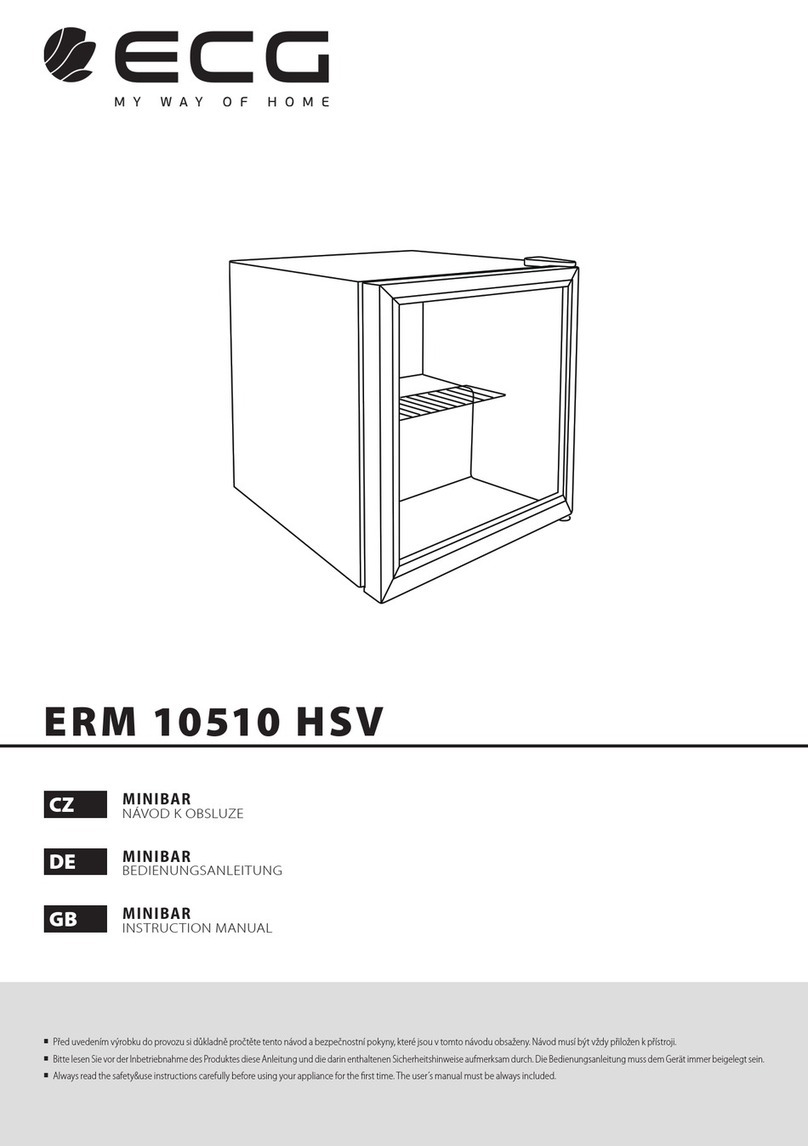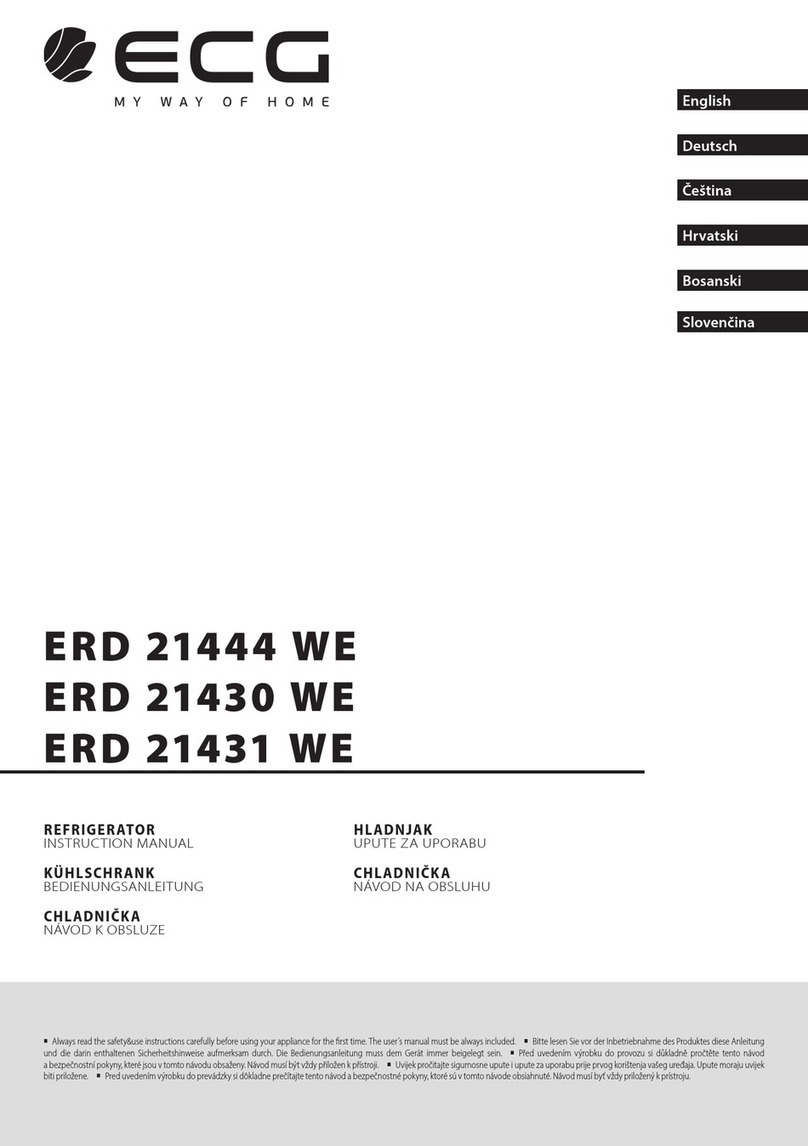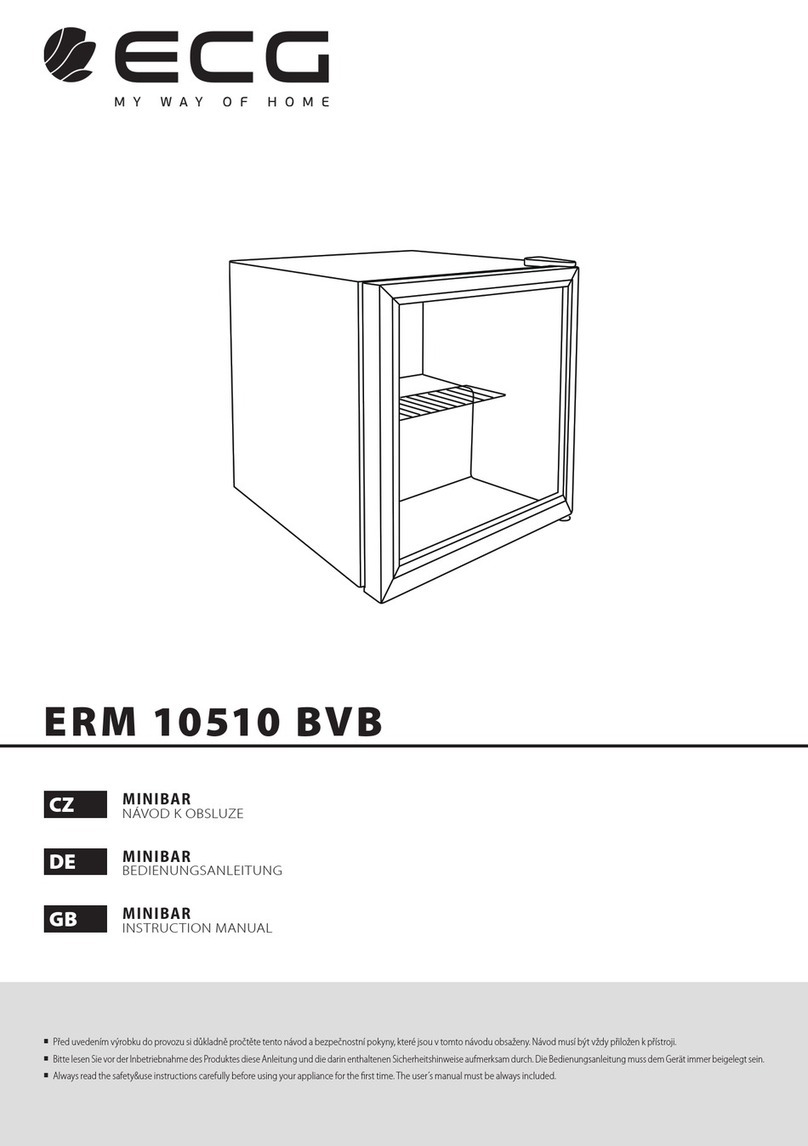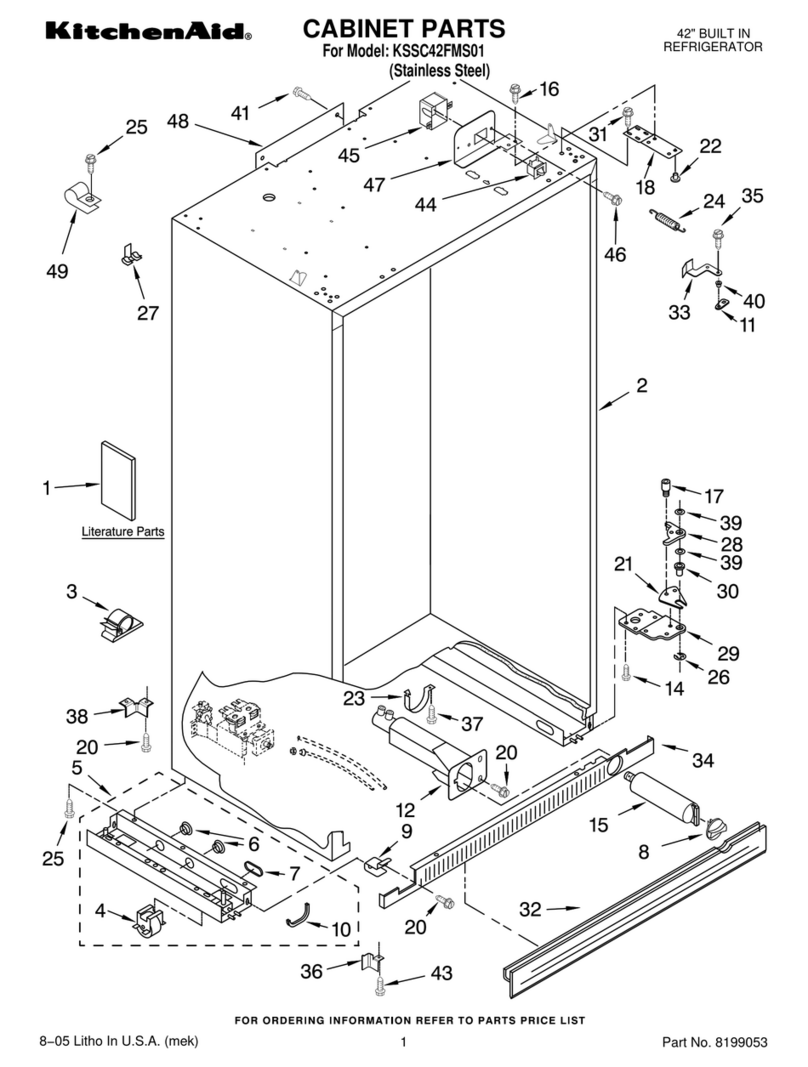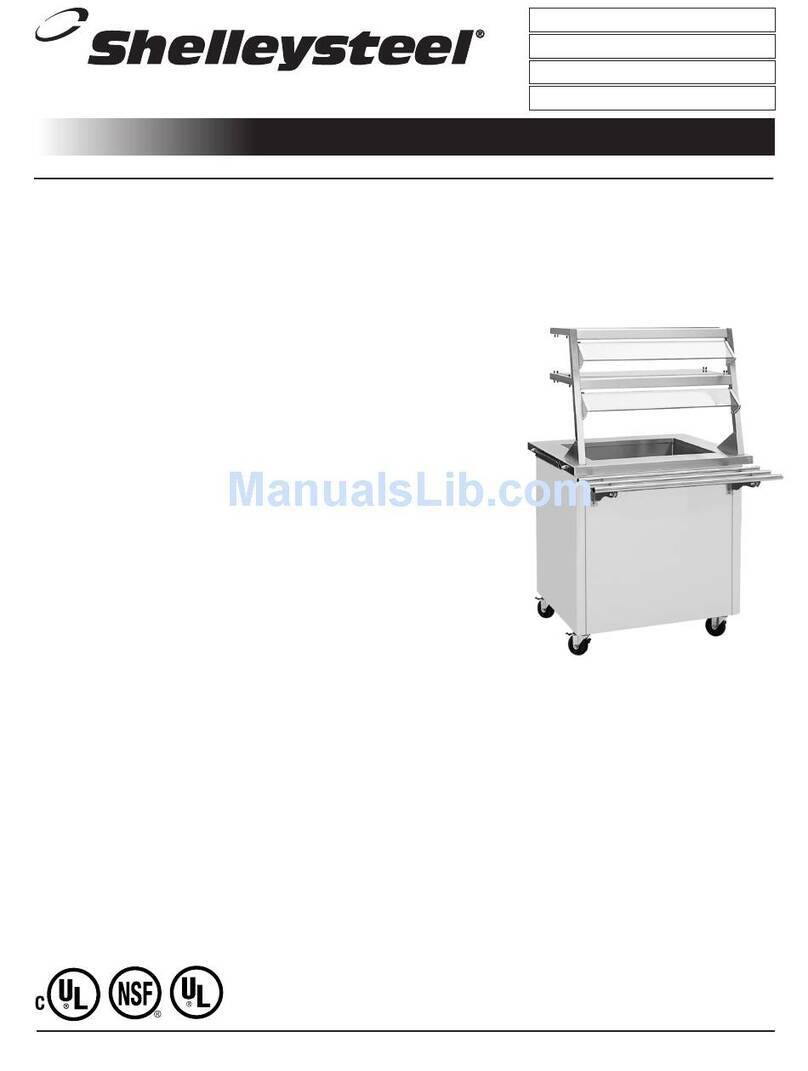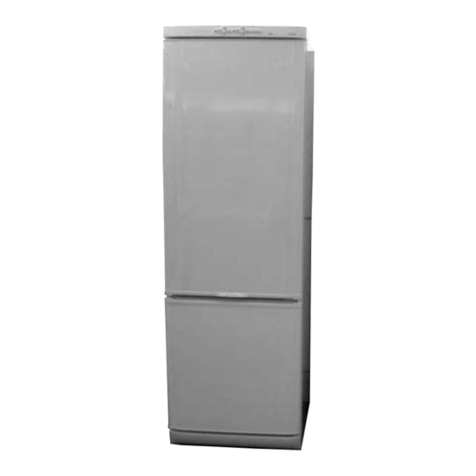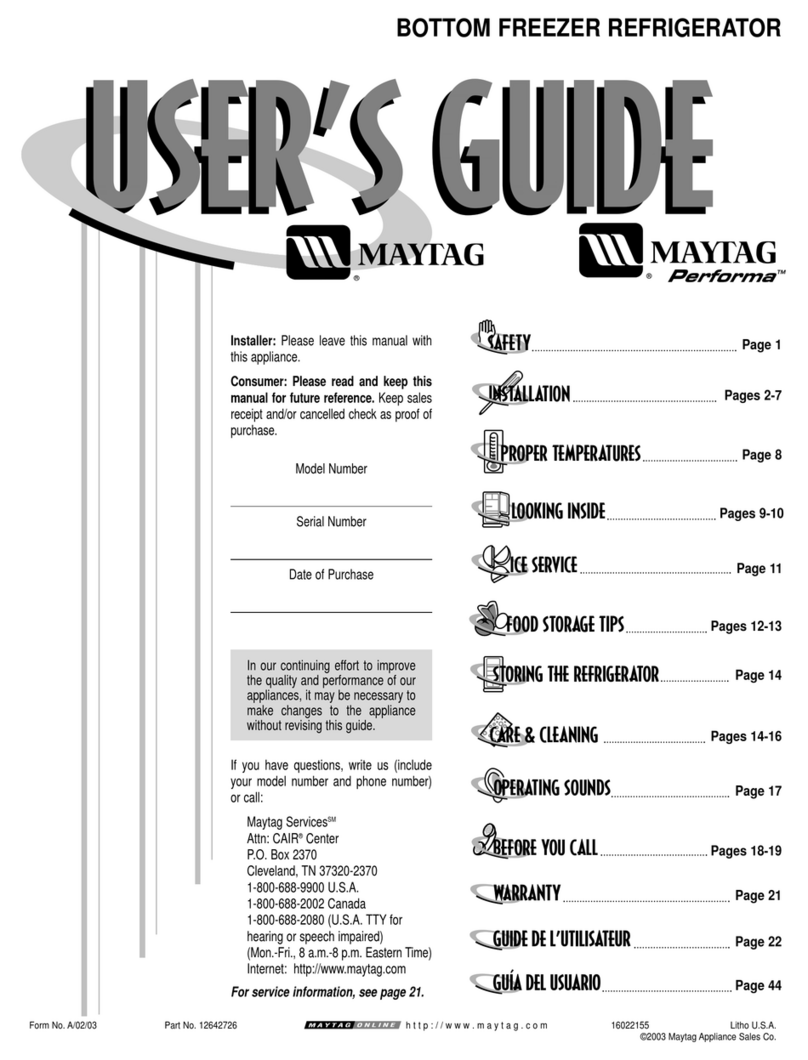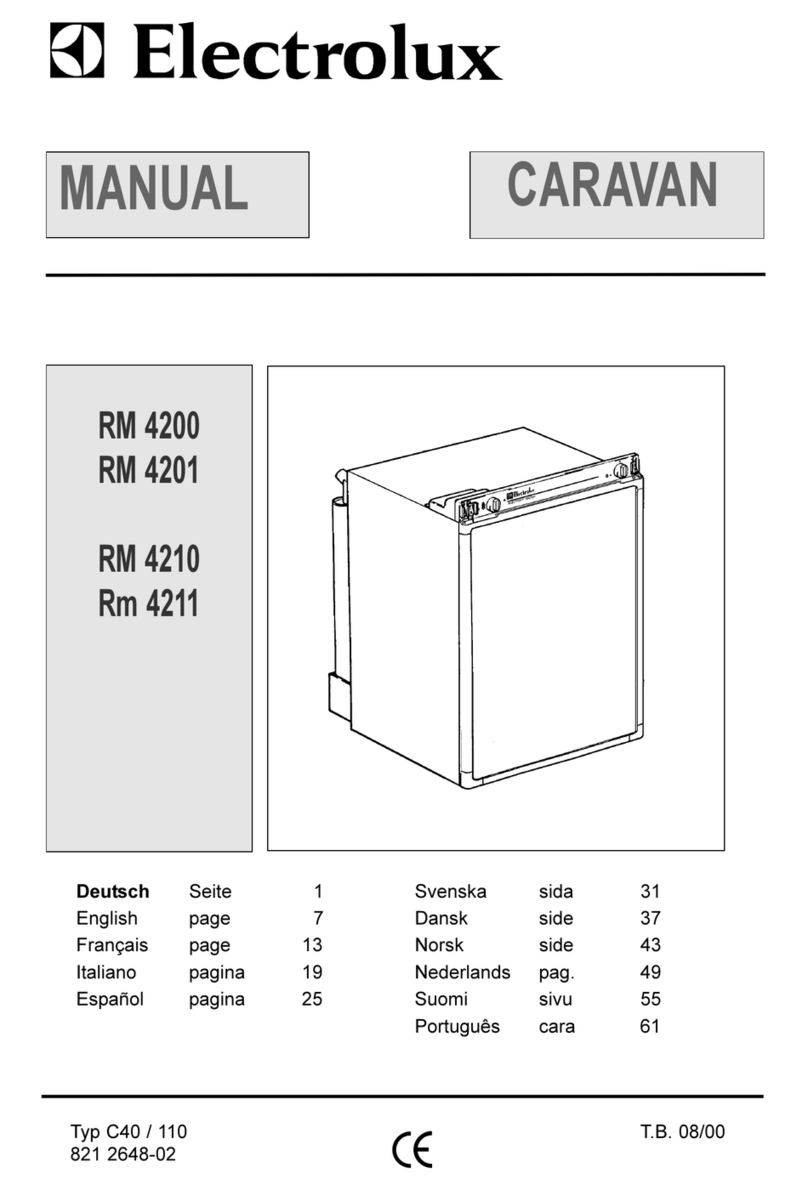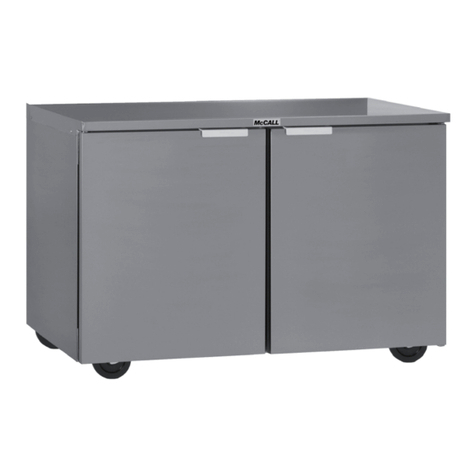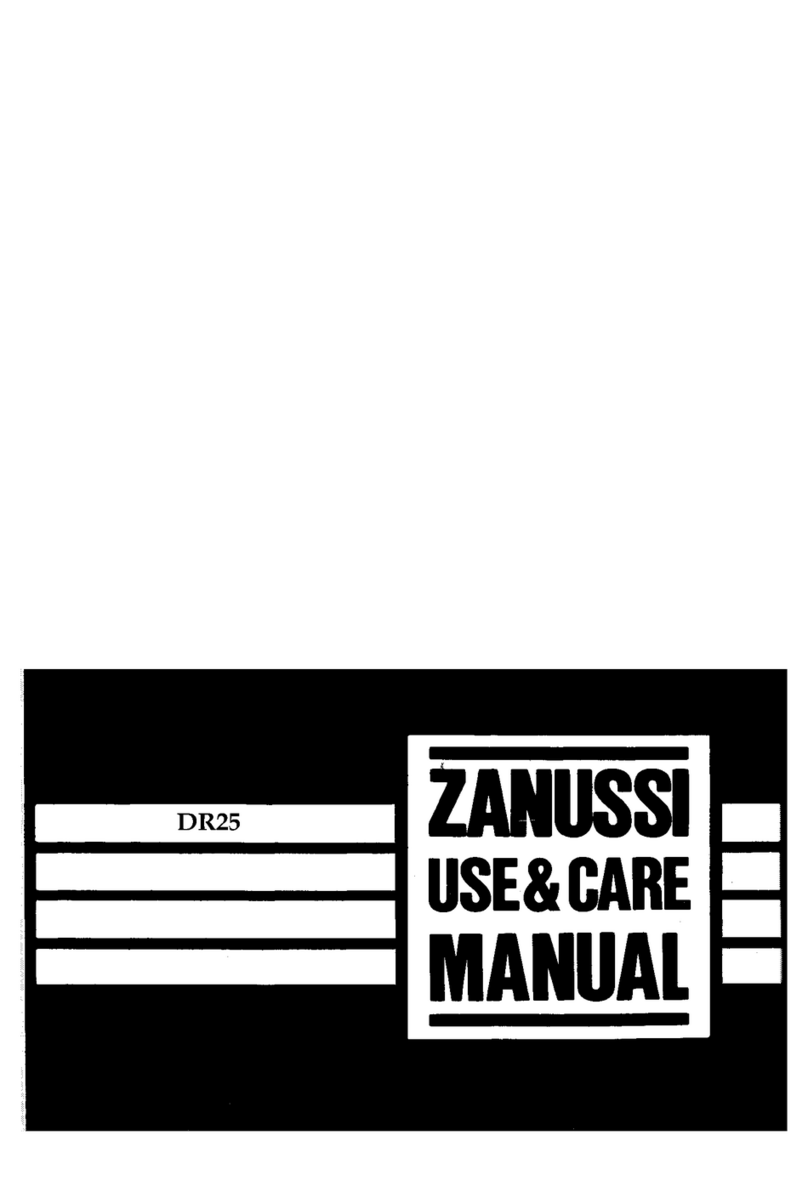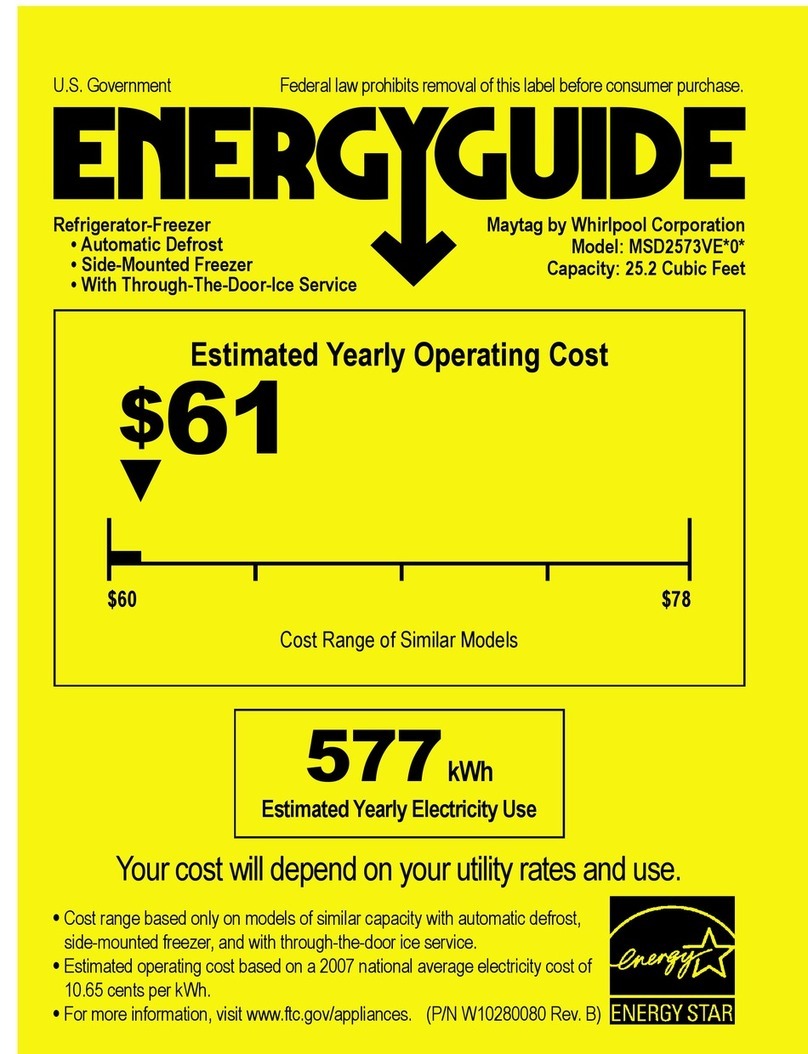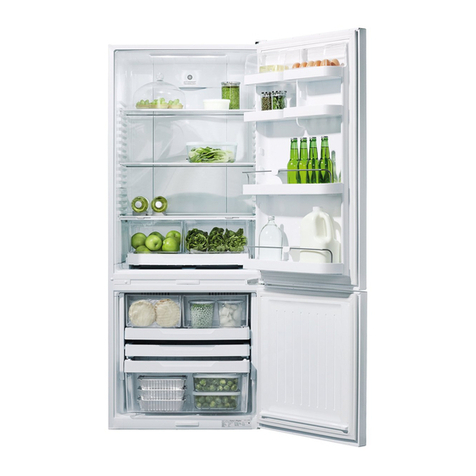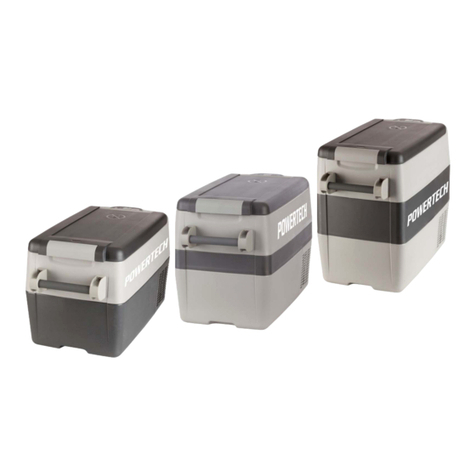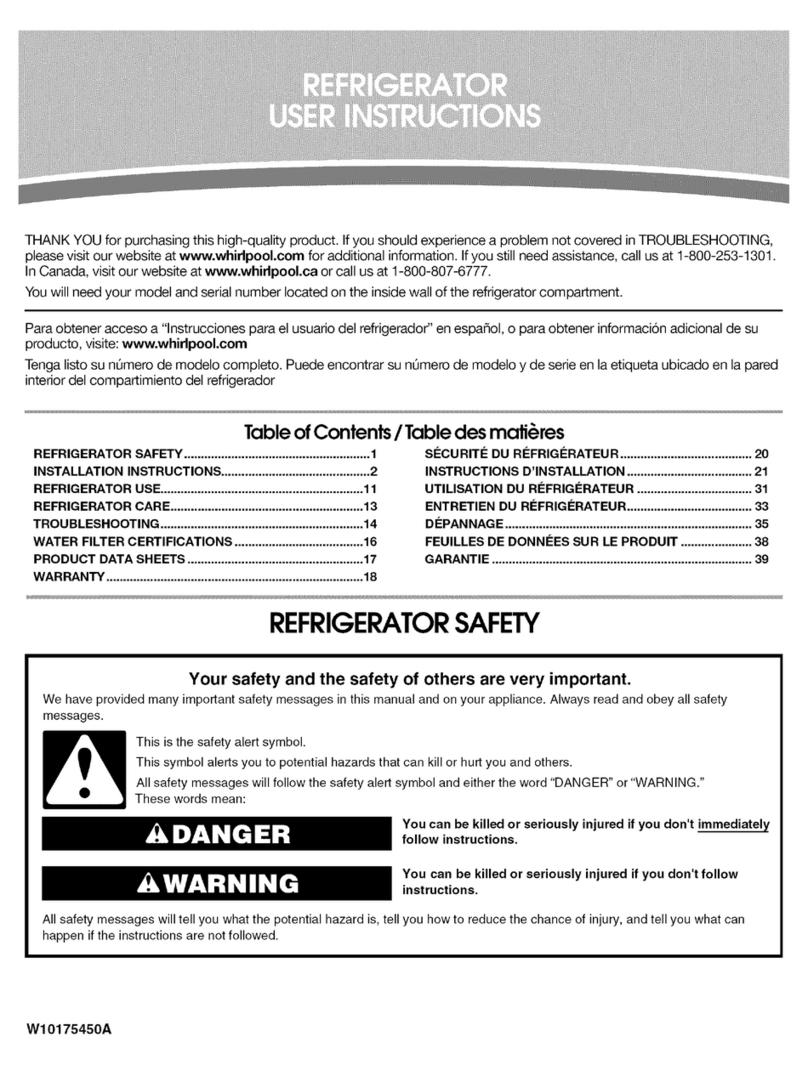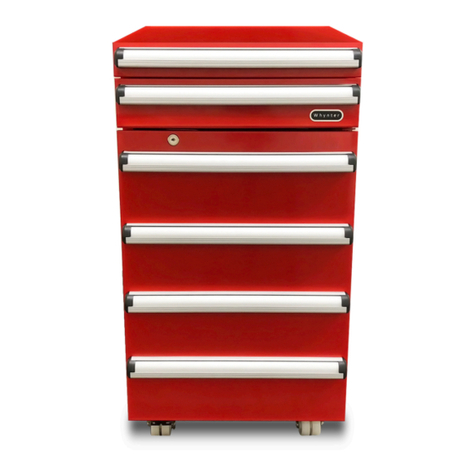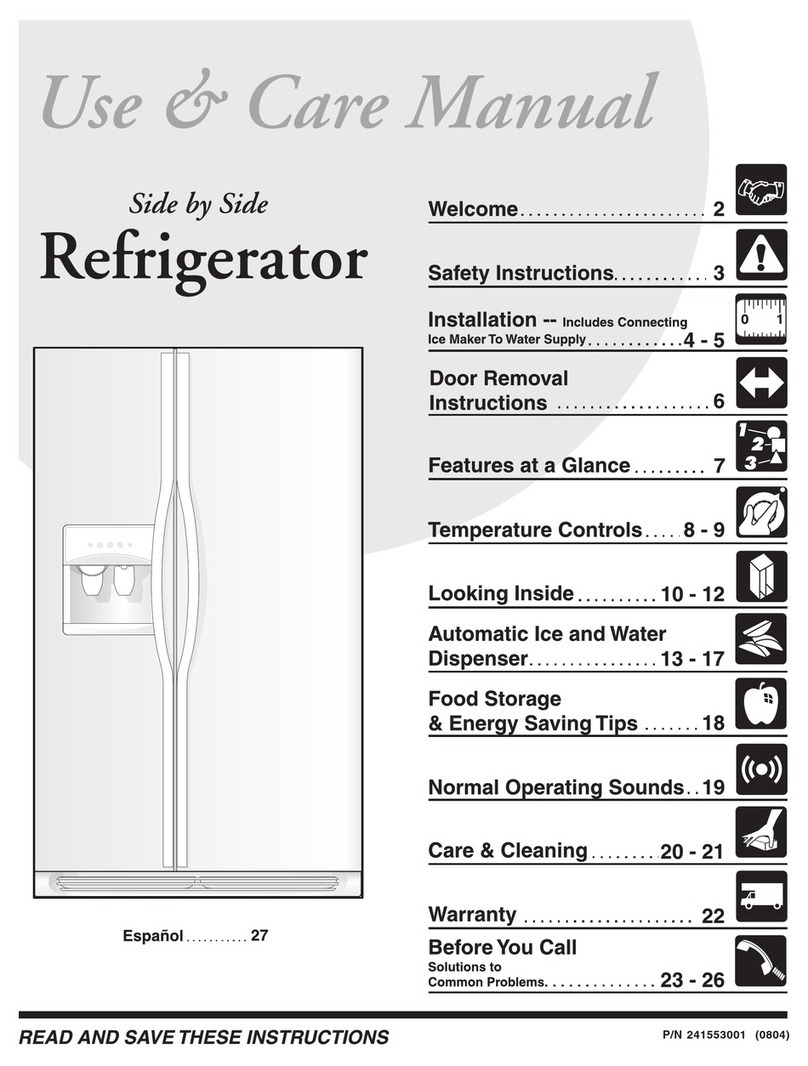ECG ERB 21880 NXE User manual

ERB 21880 NXE
English
Deutsch
Čeština
Slovenčina
Always read the safety&use instructions carefully before using your appliance for the rst time. The user´smanual must be always included. Bitte lesen Sie vor der Inbetriebnahme des Produktes diese Anleitung und
die darin enthaltenen Sicherheitshinweise aufmerksam durch. Die Bedienungsanleitung muss dem Gerät immer beigelegt sein. Před uvedením výrobku do provozu si důkladně pročtěte tento návod abezpečnostní
pokyny, které jsou vtomto návodu obsaženy. Návod musí být vždy přiložen kpřístroji. Pred uvedením výrobku do prevádzky si dôkladne prečítajte tento návod abezpečnostné pokyny, ktoré sú vtomto návode
obsiahnuté. Návod musí byť vždy priložený kprístroju.
COMBINATION REFRIGERATOR
INSTRUCTION MANUAL
KOMBINOVANÁ CHLADNIČKA
NÁVOD KOBSLUZE
KÜHL-GEFRIERKOMBINATION
BEDIENUNGSANLEITUNG
KOMBINOVANÁ CHLADNIČKA
NÁVOD NA OBSLUHU


English
English
3
COMBINED REFRIGERATOR
SAFETY INSTRUCTIONS
Read carefully and save for future use!
Warning: The safety measures and instructions, contained in this
manual, do not include all conditions and situations possible. The user
must understand that common sense, caution and care are factors
that cannot be integrated into any product. Therefore, these factors
shall be ensured by the user/s using and operating this appliance. We
are not liable for damages caused during shipping, by incorrect use,
voltage uctuation or the modication or adjustment of any part of
the appliance. To protect against a risk of re or electric shock, basic
precautions shall be taken while using electrical appliances, including
the following:
1. Make sure the voltage in your outlet corresponds to the voltage
provided on the appliance label and that the socket is properly
grounded. The outlet must be installed in accordance with
applicable electrical codes according to EN.
2. Do not operate the device if the cord is damaged. All repairs or
adjustments including cord replacements must be carried out
by a professional service centre! Do not remove the protective
covers from the appliance; there is a risk of electric shock!
3. Protect the appliance against direct contact with water and other
liquids, to prevent potential electric shock. Do not immerse cord or
plug in water!
4. Do not use the appliance in humid environments or in areas where
there may be gas leakage or contact with an explosive atmosphere.
Do not touch the cord or the device with wet hands. Risk of electric
shock.
5. The power cord must remain accessible once the device is installed.
Do not shorten the cable and do not use splitters in electric outlets.
Do not allow the cord to touch hot surfaces or place the cord over
sharp edges.
6. Do not switch the appliance on or o by plugging in or pulling out
the power supply plug. Do not remove the power cord from the
COMBINED REFRIGERATOR
English

English
English
4
outlet by yanking the cord. Unplug the power cord from the outlet
by grasping the plug.
7. Do not insert any objects into the device or place any objects on the
device (e.g. vases, cups, etc.). Never cover the ventilation openings!
8. Do not use other electrical appliances or freezing equipment in the
appliance.
9. If this appliance is replacing an old appliance with a lock, make the
lock of the old appliance inoperational to prevent children from
locking themselves inside (e.g. when playing).
10.Do not use mechanical devices or other articial means to speed
up defrosting. Do not use electrical appliances in the food storage
area. Protect the cooling circuit of the appliance against damage.
11.Do not allow children to play with the appliance. Also, they may not
sit on the shelves and hang on the door of the appliance.
12.Do not use sharp metal objects to remove ice in the refrigerator,
as they can damage the freezing circuits and cause irreparable
damage to the equipment. If necessary, use a plastic scraper.
13.Do not store explosive materials such as sprays with propellant in
the appliance.
14.Do not place containers (glass bottles or cans) with liquids in the
freezer. The container could burst.
15.Bottles containing liquids with high alcohol content must be
properly closed and placed vertically when stored.
16.Do not expose the appliance to direct sunlight, do not use it outside
and do not expose it to rain.
17.Do not touch the cooling surfaces with wet hands. Risk of injury.
18.Do not consume the ice removed from the freezer.
19.This appliance is designed for domestic use and for use in similar
places, such as:
- Kitchenettes in shops, oces and other workplaces
- appliances used by guests in hotels, motels and other residential
areas.
- appliances used in bed and breakfast residences

English
English
5
20.This appliance may be used by children under 8 years of age
and older and persons with reduced physical, sensory or mental
capabilities or lack of experience and knowledge if supervised or
instructed to use the appliance in a safe manner and understand the
potential hazards. Children shall not play with the appliance. User
cleaning and maintenance must not be performed by unsupervised
children.
21.Children aged 3 to 8 years can insert and remove food from
refrigerating appliances.
22.Child supervision is essential to prevent them from playing with the
appliance.
23.The manufacturer is not liable for any damage caused by improper
grounding/use.
24.It is necessary to keep free the ventilation openings in the cover or
in the construction of the appliance.
To prevent food contamination, please follow these recommendations:
- Opening the door for a long time can cause a signicant increase
in the temperature inside the appliance.
- Regularly clean surfaces and accessible drainage systems that may
come into contact with food.
- Clean water containers if not used for 48 h; ush the water system
connected to the water supply if the water has not owed for 5
days.
- Store raw meat and sh in the refrigerator in suitable containers
so that they do not come into contact with or drip into other
foodstus.
- Two-star freezing compartments are suitable for storing pre-
frozen food, storing or making ice cream and making ice cubes.
- One-, two- and three-star compartments are not suitable for
freezing fresh food.
- If the refrigerating appliance is left empty for a long time, turn it
o, defrost, clean, dry and leave the door open to prevent mold
formation inside the appliance.

English
English
6
RISK OF FIRE!
WARNING: RISK OF FIRE/FLAMMABLE
MATERIALS
This appliance contains R600a (isobutane coolant), natural (natural)
gas that is very environmentally friendly but ammable. When
transporting and installing the appliance it is necessary to ensure that
none of the parts of the cooling circuit is damaged. In case of damage
limit the ame and ventilate for several minutes the space where the
appliance is located.
The cooling system contains high-pressure coolant. Do not manipulate
the system. It must only be repaired by a qualied person.
When replacing the interior lighting of the refrigerator, always unplug
the refrigerator - otherwise there is a risk of electric shock. • If the
replacement of the interior lighting is too complicated for you, contact
your service representative. • If the products are equipped with LEDs,
do not remove the lighting cover and LED yourself. – contact your
service representatives.
REPLACING THE LED BULB: Do not remove the indicator cover or
indicator yourself when the internal or external LEDs no longer operate.
Contact the service representatives.
Do not replace the LED lighting yourself. Contact the service
representatives.

English
English
7
INSTALLING AND OPERATING YOUR REFRIGERATOR
Before using the refrigerator, you must pay attention to the following points:
• The operating voltage of your refrigerator is 220-240 V at 50Hz.
• The power cable of your refrigerator has a grounded plug. This outlet must be grounded in a grounded
plug that has a fuse of at least 16 amps. If you do not have a socket that meets this requirement, have it
installed by a qualied electrician.
• We are not liable for any damage that may occur due to ungrounded usage.
• Place the refrigerator where it will not be exposed to direct sunlight.
• Your appliance must be at least 50 cm from an oven, gas oven or burners and must be at least 10 cm from
an electric oven.
• Your refrigerator must not be used outdoors or left in the rain.
• When your refrigerator is placed near the freezer, there must be a distance of at least 2 cm between them
to prevent the formation of moisture on the outside surface.
• Position the refrigerator so that there is a free space in the back and on the sides of min. 10 cm. Do not
place anything on the refrigerator and place it in a suitable location so that there is at least 30 cm above
the top.
• The adjustable front legs must be adjusted to a suitable height so that the freezer can operate stably and
correctly. You can adjust the feet by turning them clockwise (or in the opposite direction). This must be
done before placing food in the refrigerator.
• Before using the freezer, wipe all internal surfaces and drawers with a cloth immersed in warm water with
a teaspoon of baking soda, then rinse with clean water and dry. Replace all parts after cleaning.
Climate class and signicance: see information sheet
T (tropical): This freezer is intended for use in ambient temperatures from 16 °C to 43 °C.
ST (subtropical): This freezer is intended for use in ambient temperatures from 16 °C to 38 °C.
N (normal): This freezer is intended for use in ambient temperatures from 16 °C to 32 °C.
SN (subnormal): This freezer is intended for use in ambient temperatures from 10 °C to 32 °C.
Climatic classes Surrounding
T16 up to 43°C
ST 16 up to 38°C
N16 up to 32°C
SN 10 up to 32°C
Before using the refrigerator
• Allow the freezer to stand for 3 hours before connecting it for the rst time or after transporting it.
Otherwise, the compressor could be damaged.
• Your refrigerator may smell at the rst start; odour disappears as soon as cooling starts.
Information about the new cooling technology
Refrigerators-freezers with the new refrigerating technology have a dierent system than static refrigerators-
freezers. In the case of conventional refrigerator-freezers, moist air is blown into the freezer and the water
evaporating from the food turns into ice in the freezer compartment. In order to remove this frost, in other
words, to defrost, the refrigerator must be disconnected from the power supply. During defrosting, the user
must put the food away and remove the remaining ice and accumulated ice.
In the case of freezers equipped with new cooling technology, the situation is quite dierent. Cool and dry air
is dispersed in the freezer compartment by means of a fan. The cold air is thus easily dispersed throughout the
space - even between the shelves, and the food is frozen properly and evenly. And no frost forms.
The conguration in the refrigerator compartment will be almost the same as in the freezer compartment.
The air dispersed by the fan at the top of the refrigerator compartment is cooled as it passes through the gap
behind the duct. In order to successfully complete the cooling process in the refrigerator compartment, air is

English
English
8
released at the same time through the openings in the duct. The vents on the duct are designed for even air
distribution in the space.
Since no air passes between the refrigerator and the freezer, no odors are mixed.
This makes the refrigerator with new cooling technology easy to use and oers you both a large volume and
an aesthetic appearance.
This appliance is not intended for use as a built-in device.
Door opening reversal
1. Turn o the refrigerator and remove all objects from the compartments in the door.
2. Remove the upper hinge cover, disconnect the cables, upper hinge and hole cover on the other side.
Remove the refrigerator door.
3. Remove the center hinge, screws, hole caps and remove the freezer door.
4. Remove the bottom hinge, hole caps and screws, install the bottom hinge shaft on the other side of the
bottom hinge, and then install the hinge on the other side.

English
English
9
5. Remove the screws, sleeve tube and plug on the bottom front cover of both door bodies and install them
one after the other on the other side of the door bodies (the plug must be replaced from the included
bag). Then remove the upper radiator door end cover and connect the wiring harness to the other side of
the door body. Finally, install the radiator door upper hinge sleeve tube in the hole on the other side of the
upper radiator door end cover.
6. Install the freezer door on the lower hinge, install the middle hinge, screws and screw hole covers.
7. Place the refrigerator compartment body on the center hinge, then install the top hinge on the other side
of the cabinet, nally connect the terminal, 2 for the signal wires on the top hinge side and terminals 3 and
4 on the other side, and cover the hinge cover and hole cover.

English
English
10
DESCRIPTION OF THE APPLIANCE AND ACCESSORIES
This presentation is for information only and concerns the components of the appliance. Parts may dier
depending on the model.
1) Refrigerator shelves
2) Freezer boxes
3) Door compartments
4) LED lighting
1
2
3
4

English
English
11
Display and control panel
External display / External control
Button A
Used to set the temperature.
Temperature setting screen
The 1to 6button show the individual temperature settings.
Display
After switching on the refrigerator, the display (including the buttons) will be fully lit for 3 s, and then the
refrigerator will run according to the temperature setting 3.
When a malfunction occurs, the combined malfunction code is displayed (cyclically on the display) using the
appropriate LED indicators. If there is no malfunction, the current temperature setting will be shown on the
LED display.
Malfunction codes
The following warnings on the display indicate refrigerator malfunctions. Although the refrigerator can operate
without problems even with these malfunctions, it is always necessary to contact an authorized service center.
Lit indicators 1and 2:Temperature sensor circuit error
Lit indicators 1and 3:Defrost sensor circuit error
Lit indicators 1and 4:Ambient temperature sensor error
Lighting (if available)
When the product is plugged in for the rst time, the interior lighting may be delayed by 1 minute due to
opening tests.
OPERATING THE REFRIGERATOR
After connecting the appliance to the mains, all symbols on the display will light up for 3 seconds, the default
setting of the cooling space is +4 ° C. The default freezer temperature is -15 ° C

English
English
12
Temperature settings
• The default refrigerator temperature is set to +4 ° C.
• To set the temperature, press the temperature change button on the display.
• The desired temperature is set within about 15 seconds.
• As the temperature in the refrigerator increases, the temperature in the freezer automatically increases,
and conversely, the colder it is in the refrigerator, the lower the temperature in the freezer.
Quick cooling function
Set the fast cooling mode by setting the temperature to indicator 6 (SUPER).
The fast cooling indicator lights up and the refrigerator cools down to 2 ° C. After 150 minutes, the quick
cooling function automatically shuts o. You can turn o the fast cooling function earlier by setting a dierent
cooling temperature.
Note concerning the temperature setting
• Your temperature setting will not be cleared if there is a power failure.
• It is not recommended to use the refrigerator in an environment where the ambient temperature is below
16 ° C.
• The temperature must be set in accordance with the frequency with which the door is opened and the
amount of food stored in the refrigerator.
• Your refrigerator must be operated for 24 hours at a given ambient temperature without interruption to
allow it to cool completely. Do not open the refrigerator door frequently and do not put too much food
in it at this time.
• The 5 minute delay function is used to prevent damage to the refrigerator compressor when you unplug
and then reconnect it or when there is a power failure. Your refrigerator starts working normally after 5
minutes.
• Your refrigerator is designed to operate at the intervals specied in the standards, in accordance with the
class indicated on the information tag. We do not recommend starting your refrigerator outside the stated
limits, so that you can achieve eective cooling.
• This appliance is designed for use at an ambient temperature of 16 ° C - 38 °C.

English
English
13
CLEANING AND MAINTENANCE
• Make sure that the refrigerator is unplugged before you start cleaning it.
• Do not clean the refrigerator with running water.
• You can wipe the inside with a soft cloth and a sponge soaked in warm water with
detergent.
• Remove the individual parts and wash them with water and
detergent. Do not wash in the dishwasher.
• Never use ammable, explosive or corrosive cleaning agents, such as thinner, gasoline,
acid, for cleaning.
• You must clean the condenser with a brush once a year to save energy and increase
productivity.
Warning: Make sure that your refrigerator is unplugged during the cleaning.
Defrosting
Your refrigerator performs fully automated defrosting. The water accumulated as
a result of defrosting passes into the evaporating vessel and there evaporates on
its own.
Replacing the LED indicator
Replacement of the LED must be performed by an authorized service center or
other person qualied to do so.
FOOD DISTRIBUTION IN THE APPLIANCE
Refrigerator
• Setting the refrigerator temperature to 4°C will be sucient to achieve normal operating conditions.
• To reduce humidity and consequent increase of ice, never place there liquids in unsealed containers. Frost
tends to accumulate in the coldest parts of the evaporator and therefore more frequent defrosting is
required.
Evaporating
containers

English
English
14
• Never put warm foods in the refrigerator. Hot food must be allowed to cool to room temperature and
adequate air circulation must be ensured in the refrigerator compartment.
• Nothing should touch the back wall, as this will cause ice to accumulate and the packages may stick to the
back wall. Do not open the refrigerator door too frequently.
• Place meat and cleaned sh (wrapped in bags or plastic wrap) that you consume within 1-2 days in the
bottom of the refrigerator (above the crisper), as this is the coldest part and this will ensure the best
storage conditions.
• You can put fruits and vegetables in the crisper unpacked.
• Under normal operating conditions, it is sucient to adjust the refrigerator temperature setting to +4 ° C.
• The temperature of the refrigerator compartment should be between 0-8 ° C, fresh food is icy and rotting
at temperatures below 0 ° C, and at temperatures above 8 ° C the amount of bacteria increases and the
food spoils.
• Do not put hot food in the refrigerator; let it cool down to room temperature.
• Hot foods raise the temperature of the refrigerator and can cause food poisoning or unnecessary spoilage.
• Meat, sh and similar foods should be stored in the chiller and vegetables in the vegetable compartment
(if available).
• To avoid cross-contamination, do not store meat products with fruits and vegetables.
• Food in the refrigerator should be stored in closed containers or other suitable containers so as not to
release odors and moisture into the refrigerator.
Food Storage length Which part of the refrigerator to use for
storing
Fruits and vegetables 1 week In the crisper drawer (no packaging)
Meat and sh 2–3 days Covered with plastic wrap or bags or in a
meat box (on a glass shelf)
Fresh cheese 3–4 days On a special shelf in the door
Butter and margarine 1 week On a special shelf in the door
Bottled products, milk and
yogurt
Until the expiration date
recommended by the
manufacturer.
On a special shelf in the door
Eggs 1 month In the egg rack
Cooked food All shelves
Freezer
• Please use a freezer for long-term storage of frozen food and ice making.
• To achieve maximum freezer capacity, use glass shelves at the top and middle. Place a lower basket in the
bottom.
• To achieve ideal appliance performance and maximum freezing capacity, set the refrigerator to 4 ° C for 24
hours before placing fresh food in the freezer.
• Usually, changing the setting to 2°C for 24 hours is sucient when fresh food is placed in the freezer. You
can lower the setting if necessary after 24 hours.
• Do not place in foods which you want to freeze close to already frozen foods.
• The foods you want to freeze (meat, ground meat, sh, etc.) must be divided into portions before freezing
to allow them to be consumed at one time.
• Once the foods are thawed, do not freeze them again.This could cause you health problems, such as food
poisoning.
• Do not put hot food in the freezer, let it cool down rst.This would disrupt the deep freezing of other foods.
• When you buy frozen food, make sure that it has been frozen under suitable conditions and that the
packaging is not damaged.

English
English
15
• When storing frozen food, the storage conditions stated on the packaging must be observed. If no
explanation is given, the food must be consumed as soon as possible.
• If the frozen food became damp and felt uncomfortable, the food could have been stored in unsuitable
conditions and spoiled as a result. Do not buy this type of food!
• The length of storage of frozen food depends on the ambient temperature, the frequency of door opening,
the thermostat setting, the type of food and the time that has elapsed between the purchase of the food
and its placement in the freezer. Always follow the packaging instructions and never exceed the stated
storage time.
• Note that it is not easy to open the freezer door immediately after closing.That is entirely normal. Once the
pressure is even, the door can be opened easily.
Important note:
• Frozen foods can be cooked just like fresh foods after thawing. If they are not cooked after thawing, they
must NEVER be re-frozen.
• The taste of some types of spices in cooked dishes (anise, basil, parsley, wine vinegar, ginger, garlic,
mustard, thyme, pepper, marjoram, etc.) changes and intensies during long-term storage.Therefore, only
a small amount of spice should be added to the frozen food or the spice can only be added after thawing.
• The storage time depends on the oil used. Suitable oils are margarine, veal tallow, olive oil, butter and
unsuitable are peanut oil and lard.
• Food in liquid form must be frozen in plastic containers, other food must be frozen in plastic foils or bags.
TRANSPORT AND RELOCATION
• The original packaging and foam (optional) must be kept for relocation.
• You must secure the refrigerator in the packaging, using straps or strong cables,
and follow the transport instructions that are on the packaging.
• Remove moving parts (shelves, accessories, vegetable compartments, etc.) or
fasten them in the refrigerator with straps to prevent bumping them during
relocation and transport.
Transport the refrigerator in vertical position.
Moving the door
• The door opening direction can be changed for models without handles.
• If the opening direction of your freezer is to be changed, you must contact the nearest authorized service
center and request a change of opening direction.
BEFORE CONTACTING THE AFTER SALES SERVICE
Check notices
Your refrigerator warns you if any of the parts are not working. In this case, the LED around the button will ash
and an audible alert will sound.
Error type Meaning Why What to do
SR Error alert Some part/Some parts are
out of order.
Contact the service as soon
as possible.
If your refrigerator does not work:
• Has there been a power failure?
• Is the plug inserted properly?
• Is the fuse of the socket where the plug is inserted burned out?
• Was there a problem with the outlet? To check this, plug the refrigerator into a an outlet you know is
working.

English
English
16
If your freezer doesn't cool enough:
• Is the temperature setting correct?
• Are the refrigerator doors opened frequently and left open for a long time?
• Is the refrigerator door properly closed?
• Have you put food in the refrigerator that is in contact with the back of the refrigerator, thus preventing
air circulation?
• Isn’t the refrigerator lled too much?
• Is there enough space between the refrigerator and the wall?
• Is the ambient value within the range of values specied in the operating instructions?
If the food in your refrigerator is overcooled
• Is the temperature setting correct?
• Isn't there too much food in the freezer? If so, your refrigerator may cool the food too much, and it will run
longer to cool the food.
If your refrigerator is too noisy:
To maintain the set cooling level, the compressor is activated from time to time. The noise that comes out of
the refrigerator at such a moment is perfectly normal. When the desired cooling level is reached, the noise is
automatically reduced. If the noise persists:
• Is your appliance stable? Are the feet adjusted?
• Is there an obstacle behind the refrigerator?
• Are vibrating the shelves or the dishes? In this case, move the shelves and / or dishes.
• The objects located on your refrigerator are vibrating.
sounds:
Cracking sound (ice cracking):
• During automatic defrosting.
• When the appliance is heated or cooled (due to expansion of the material).
Short crack: You will hear this sound when the thermostat turns the compressor on and o.
Compressor noise (normal motor sound): This noise means that the compressor works normally. The
compressor can cause more noise for a short time after it starts.
Bubbling sound: This sound is caused by refrigerant ow in the system tubes.
Sound of running water: Normal sound of running water owing into the evaporator during defrosting. This
sound can be heard during defrosting.
Air blowing sound (normal fan sound): This sound can be heard in the No-Frost refrigerator during normal
system operation due to air circulation.
If moisture forms in the refrigerator:
• Were the foods properly packed? Were the containers well dried before being placed in the refrigerator?
• Does the refrigerator door open often? When the door is opened, moisture in the air in the room enters
the refrigerator. In particular, if the humidity in the room is high, the more often the refrigerator door is
opened, the more often moisture will accumulate.
• It is normal for water drops to form on the rear wall of the refrigerator during automatic defrosting. (For
static models)
If the door is does not properly open and close:
• Does the packaging of food prevent the door from closing?
• Were the shelves, drawers and accessories in the refrigerator door installed correctly?
• Is the door seal worn or damaged?
• Is the refrigerator standing on a at surface?
If the edges of the refrigerator that are in contact with the door are hot:
Especially in summer (warm weather), the joint surfaces may become hot during compressor operation, which
is normal.

English
English
17
Important notes:
• After a sudden power failure or after the appliance has been disconnected, the compressor protection
function is activated because the gas in the cooling system has not yet stabilized. This is normal, the
refrigerator will restart after about 4 or 5 minutes.
• The cooling unit of your refrigerator is hidden in the back wall. This may cause drops of water or frost on
the back of your refrigerator due to the operation of the compressor at specied intervals. This is normal.
If the frost is not excessive, defrosting is not necessary.
• If you will not use the refrigerator for an extended period of time (e.g. during vacation), disconnect it.
Clean the refrigerator according to the instructions in section 4 and leave the door open to prevent the
accumulation of moisture and odors.
• The purchased appliance is intended for household use and can only be used in the home environment
and for specied purposes. It is not suitable for commercial or public use. If the user uses the appliance in
a way that is contrary to the above functions, we emphasize that the manufacturer and the seller are not
responsible for any repairs and failures during the warranty period.
• If the problem persists after you followed the instructions above, contact an authorized service center.
POWER SAVING TIPS
1. Install the appliance in a cool, well ventilated room, but not in direct sunlight or near a heat source
(radiator, stove, etc.). Otherwise, use an insulation board.
2. Allow hot food and beverages to cool before placing them in the appliance.
3. When thawing food, put it in the refrigerator. The low temperature of frozen foods will help cool the
refrigerator compartment. You will save energy. If the frozen food is thawed outside, it's a waste of energy.
4. Beverages must be covered when placed in. Otherwise, the humidity in the appliance will increase. And
everything will take longer. Covering the beverages also helps to preserve the taste and aroma.
5. When inserting food and beverages, open the appliance door as short time as possible.
6. Keep the covers of the various parts in the appliance closed (crisper, chiller, etc.).
7. The door seal must be clean and exible. Replace it when worn.
USE AND DISPOSAL OF WASTE
Wrapping paper and corrugated paperboard – deliver to scrapyard. Packing foil, PE bags, plastic elements – throw into plastic
recycling containers.
DISPOSAL OF PRODUCTS AT THE END OF LIFETIME
Disposal of electric and electronic equipment (valid in EU member countries and other European
countries with an implemented recycling system)
The represented symbol on the product or package means the product shall not be treated as domestic waste.
Hand over the product to the specied location for recycling electric and electronic equipment. Prevent negative
impacts on human health and the environment by properly recycling your product. Recycling contributes to
preserving natural resources. For more information on the recycling of this product, refer to your local authority,
domestic waste processing organization or store, where you purchased the product.
This product complies with EU directives on electromagnetic compatibility and electrical safety.
This product meets the requirements for heavy metals in electrical equipment.
The operating instructions are available on the website .
Changes of text and technical parameters reserved.
Old refrigerators and freezers contain insulating gases and freezing medium, which must be disposed of.
Entrust the disposal to a competent local waste disposal service. If in doubt, contact your local authorities or
your vendor. Make sure that the pipes of the cooling unit, which will be removed by the appropriate waste
disposal,service are not damaged.
• Please refer to the attached Warranty Sheet or www.ecg-electro.eu for professional service of this product.
• The warranty for this product is 24 months.
08/05

English
English
18
• Spare parts listed in EU 2019/2019 are available for 7 years.
• You can access the product database, where model information is stored (according to EU 2019/2016) by
reading the QR code on the energy label.

Deutsch
Deutsch
19
KÜHLGEFRIERKOMBINATION
SICHERHEITSHINWEISE
Bitte aufmerksam lesen undgut aufbewahren!
Warnung:DieindieserAnleitungangeführtenSicherheitsvorkehrungen
und Hinweise umfassen nicht alle Umstände und Situationen, zu denen
es kommen könnte. Der Anwender muss begreifen, dass der gesunde
Menschenverstand, Vorsicht und Sorgfalt zu Faktoren gehören, die
sich in kein Produkt einbauen lassen. Diese Faktoren müssen durch
den Anwender bzw. mehrere Anwender bei der Verwendung und
Bedienung dieses Gerätes gewährleistet werden. Wir haften nicht
für Schäden, die durch Transport, eine unsachgemäße Verwendung,
Spannungsschwankungen sowie eine Änderung oder Modikation
des Gerätes entstehen. Vermeiden Sie Brände und Stromunfälle,
indem Sie bei der Verwendung von elektrischen Geräten u.a. folgende
Grundmaßnahmen einhalten:
1. Vergewissern Sie sich, dass die Spannung der Steckdose mit der
Spannung auf dem Etikett übereinstimmt und die Steckdose
ordnungsgemäß geerdet wurde. Die Steckdose muss gemäß
geltender elektrotechnischer Norm (EN) installiert werden.
2. Benutzen Sie das Gerät nicht, falls das Stromkabel beschädigt
ist. Lassen Sie sämtliche Reparaturen, Einstellungen und das
Auswechseln des Stromkabels durch einen autorisierten
Kundendienst vornehmen! Demontieren Sie niemals die
Schutzabdeckungen des Gerätes. Dies könnte zu einem
Stromunfall führen!
3. Schützen Sie das Gerät vor direktem Kontakt mit Wasser und
sonstigenFlüssigkeiten,um Stromunfällezuvermeiden.Stromkabel
oder Stecker niemals ins Wasser tauchen!
4. Gerät niemals in einer feuchten Umgebung oder in Räumen
benutzen, in denen Gas entkommen könnte oder Kontakt mit einer
explosiven Atmosphäre droht. Stromkabel oder Gerät niemals mit
nassen Händen berühren. Es könnte zu einem Stromunfall kommen.
5. Der Netzstecker sollte auch nach der Installation des Gerätes leicht
erreichbar sein. Verkürzen Sie nicht das Kabel und benutzen keine
KÜHL-GEFRIERKOMBINATION
Deutsch

Deutsch
Deutsch
20
Mehrfachsteckdosen. Das Stromkabel darf nicht mit heißen Teilen
in Berührung kommen oder über scharfe Kanten führen.
6. Schalten Sie das Gerät nicht durch Ein-/Ausziehen des Steckers
ein oder aus. Ziehen Sie nicht am Kabel, um den Stecker aus der
Steckdose zu ziehen. Ziehen Sie am Stecker, um das Kabel aus der
Steckdose zu ziehen.
7. Stecken Sie keine Gegenstände in die Geräteönungen und stellen
Sie auf das Gerät keine Gegenstände (z.B. Vasen oder Tassen).
Belüftungsönungen niemals verdecken!
8. Benutzen Sie innerhalb des Verbrauchsgerätes keine anderen
Elektrogeräte oder Gefrieranlagen.
9. Falls dieser Verbraucher ein ausgedientes Gerät mit Schloss ersetzen
soll, entfernen Sie zunächst das Schloss an diesem Gerät. Die Tür
könnte sich versehentlich abschließen und Kinder im Verbraucher
einsperren (z.B. beim Spielen).
10.Benutzen Sie weder mechanische Vorrichtungen noch sonstige
Hilfsmittel, um das Abtauen zu beschleunigen. Benutzen Sie keine
Elektrogeräte im Bereich, in dem Lebensmittel aufbewahrt werden.
Schützen Sie den Kühlkreislauf vor Beschädigungen.
11.Kinder dürfen nicht mit dem Gerät spielen. Weiter dürfen sie nicht
auf Regalen sitzen oder sich an die Tür des Verbrauchers hängen.
12.Benutzen Sie zum Entfernen von Eis keine scharfen
Metallgegenstände, da diese den Kühlkreislauf beschädigen und
zu irreparablen Schäden führen könnten. Falls nötig, benutzen Sie
eine Kunststospatel.
13.Lagern Sie im Verbraucher keine Sprengstoe wie z.B. Sprühdosen
mit Treibgas.
14.Sie sollten im Gefrierschrank keine Verpackungen (Glasaschen
oder Konserven) mit Flüssigkeiten aufbewahren. Das Gefäß könnte
zerspringen.
15.Flaschen mit Flüssigkeiten mit einem hohen Alkoholgehalt müssen
gut verschlossen und vertikal gelagert werden.
16.Setzen Sie das Gerät weder Sonnenlicht noch Regen aus. Benutzen
Sie das Gerät nicht im Freien.
Table of contents
Languages:
Other ECG Refrigerator manuals
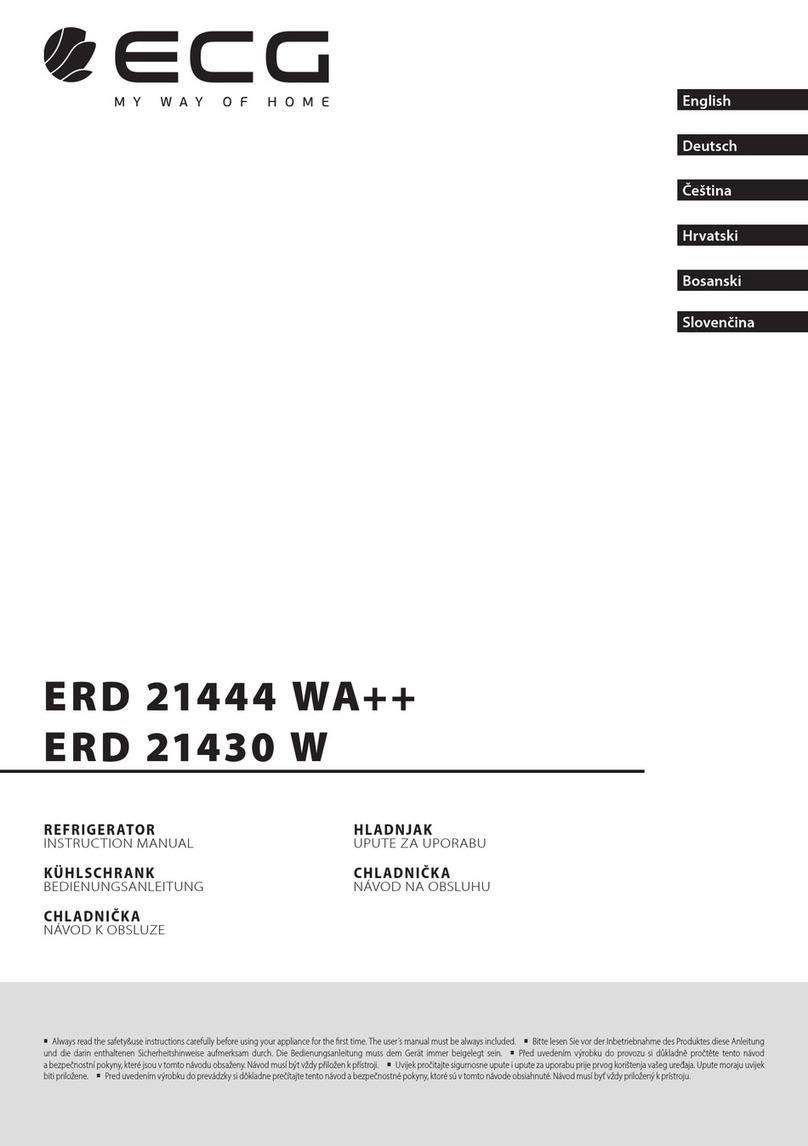
ECG
ECG ERD 21444 WA++ User manual
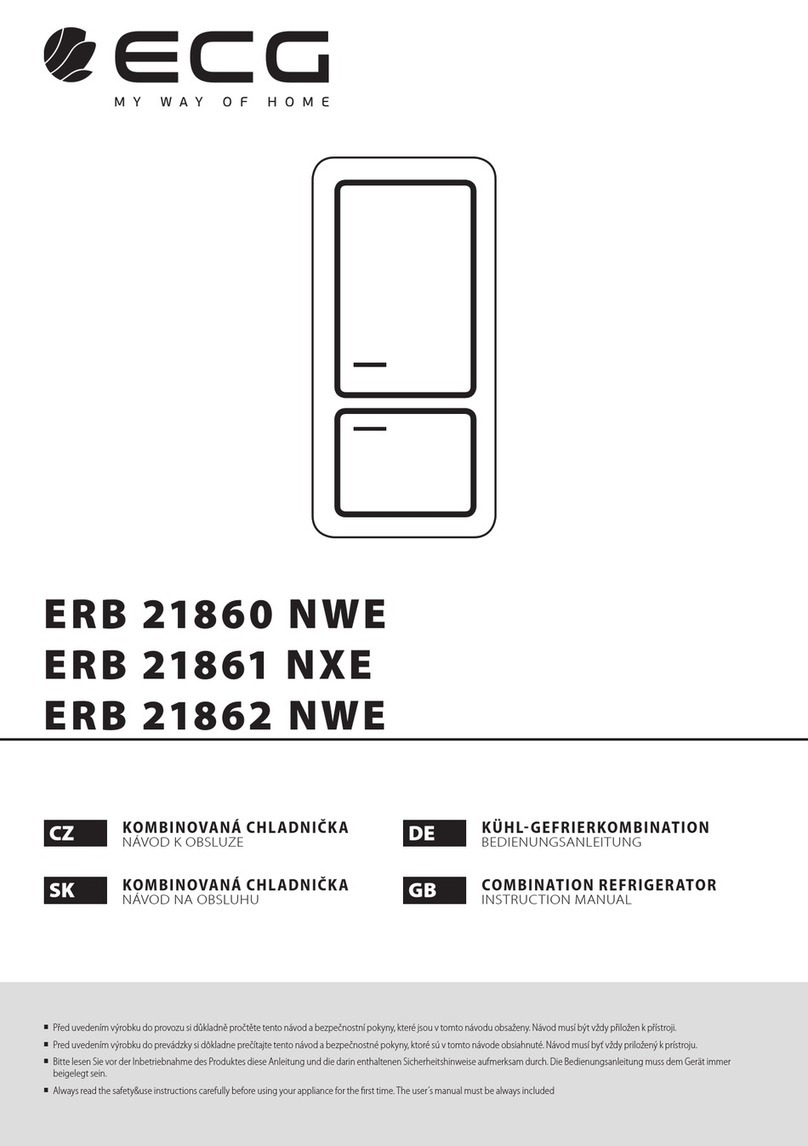
ECG
ECG ERB 21862 NWE User manual

ECG
ECG ERB 21860 NWE User manual

ECG
ECG ERM 10470 WF User manual
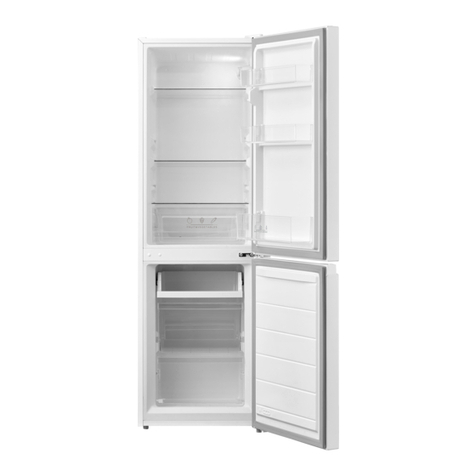
ECG
ECG ERB 21500 WF User manual
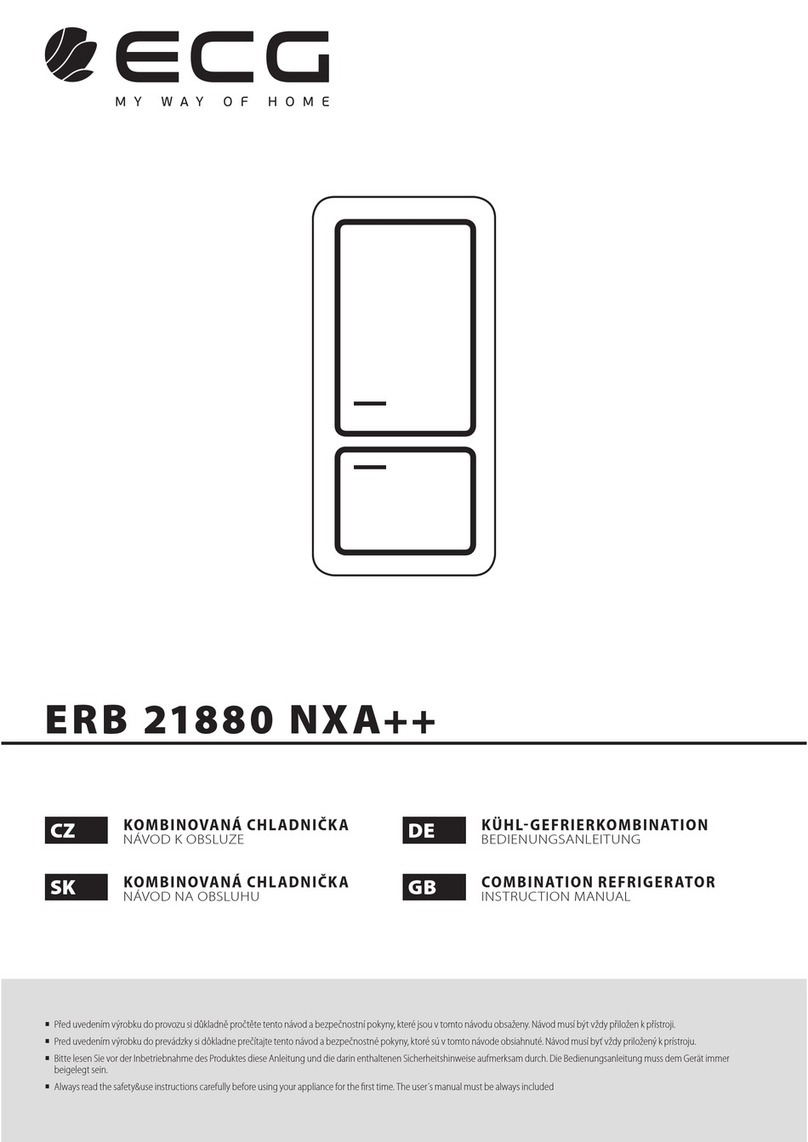
ECG
ECG ERB 21880 NXA++ User manual

ECG
ECG ERM 10510 BRM User manual

ECG
ECG ERM 10470 WA+ User manual

ECG
ECG ERM 10471 WA++ User manual
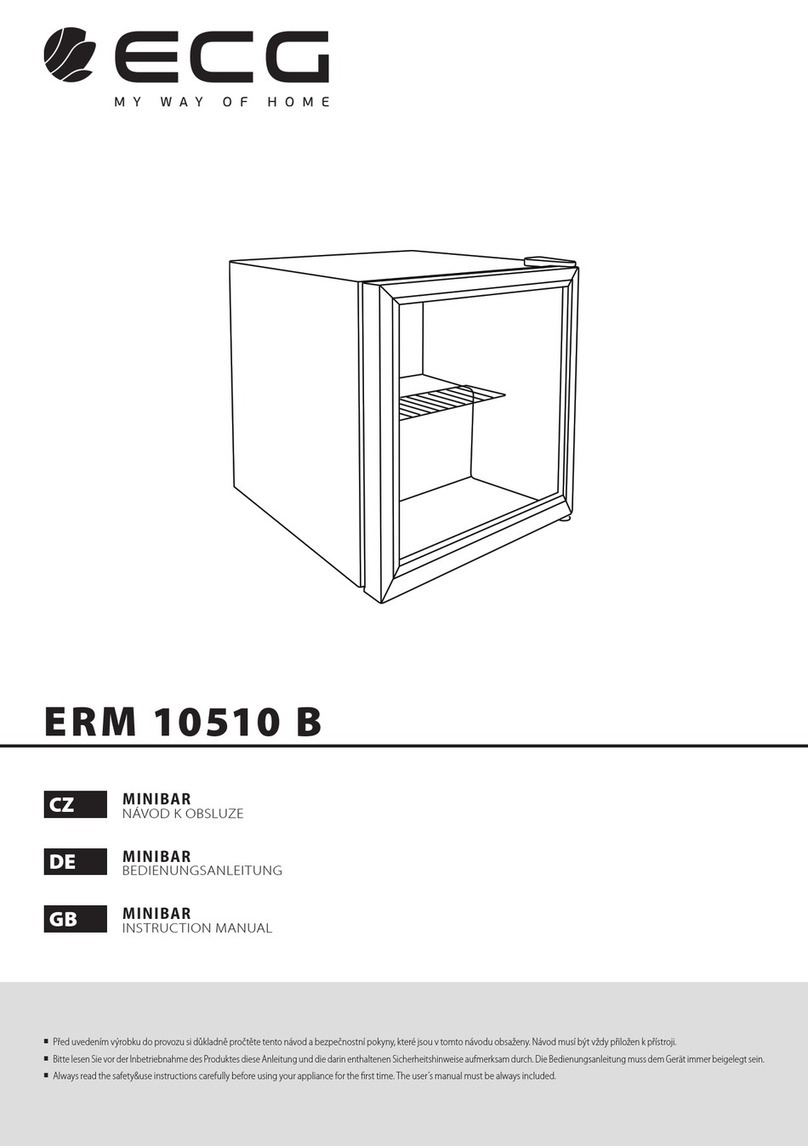
ECG
ECG ERM 10510 B User manual

ECG
ECG ERS 21780 NWA+ User manual
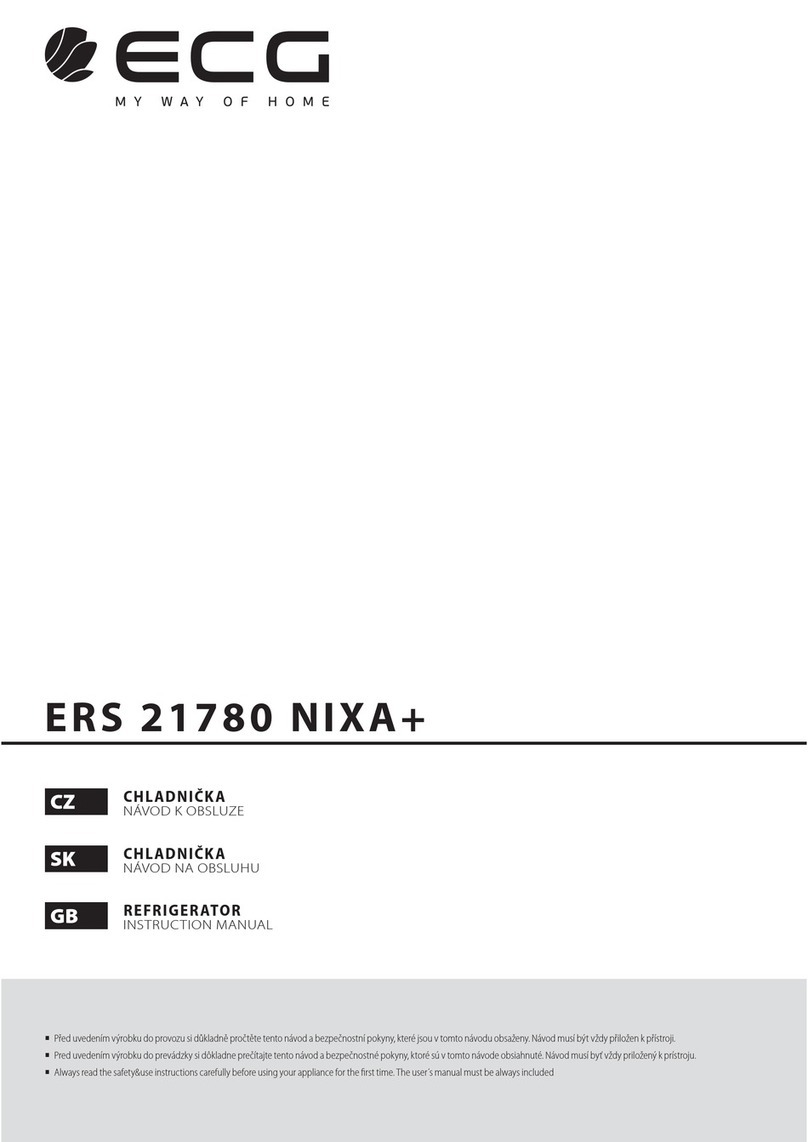
ECG
ECG ERS 21780 NIXA+ User manual

ECG
ECG EFRT 11770 NWE User manual

ECG
ECG ERB 21420 WF User manual
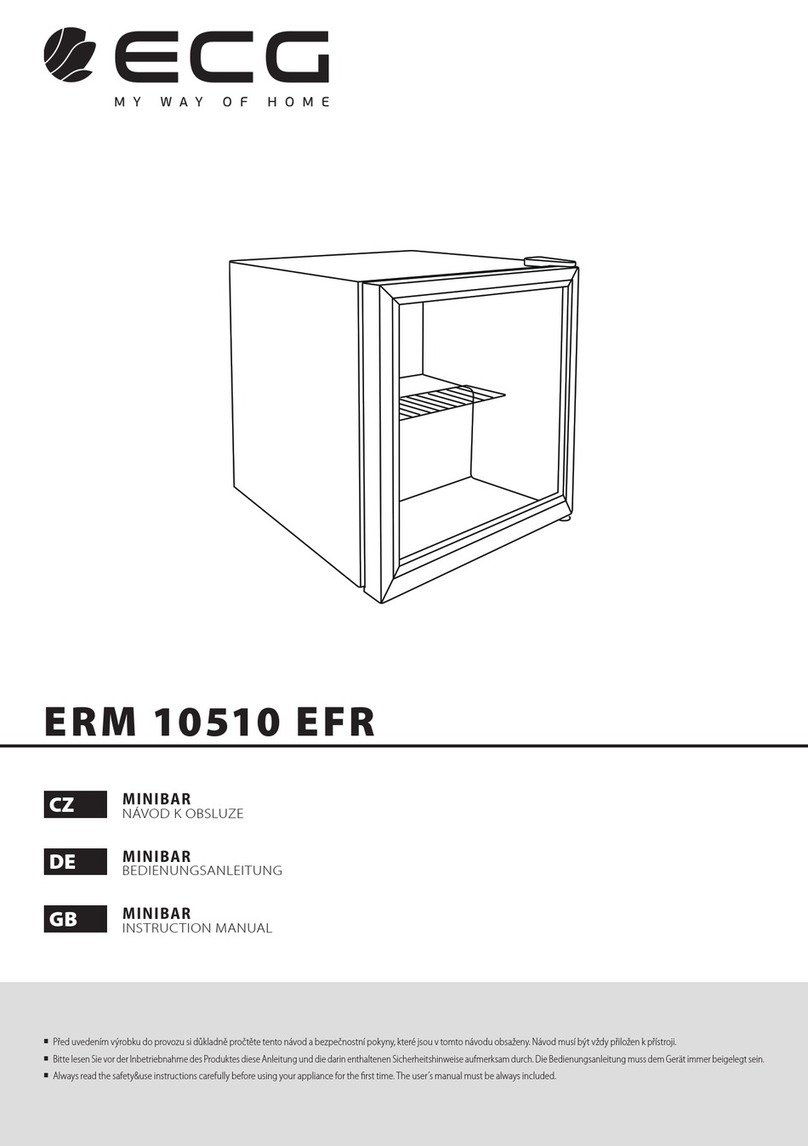
ECG
ECG ERM 10510 EFR User manual

ECG
ECG ERB 21861 NXE User manual

ECG
ECG ERB 21420 W User manual
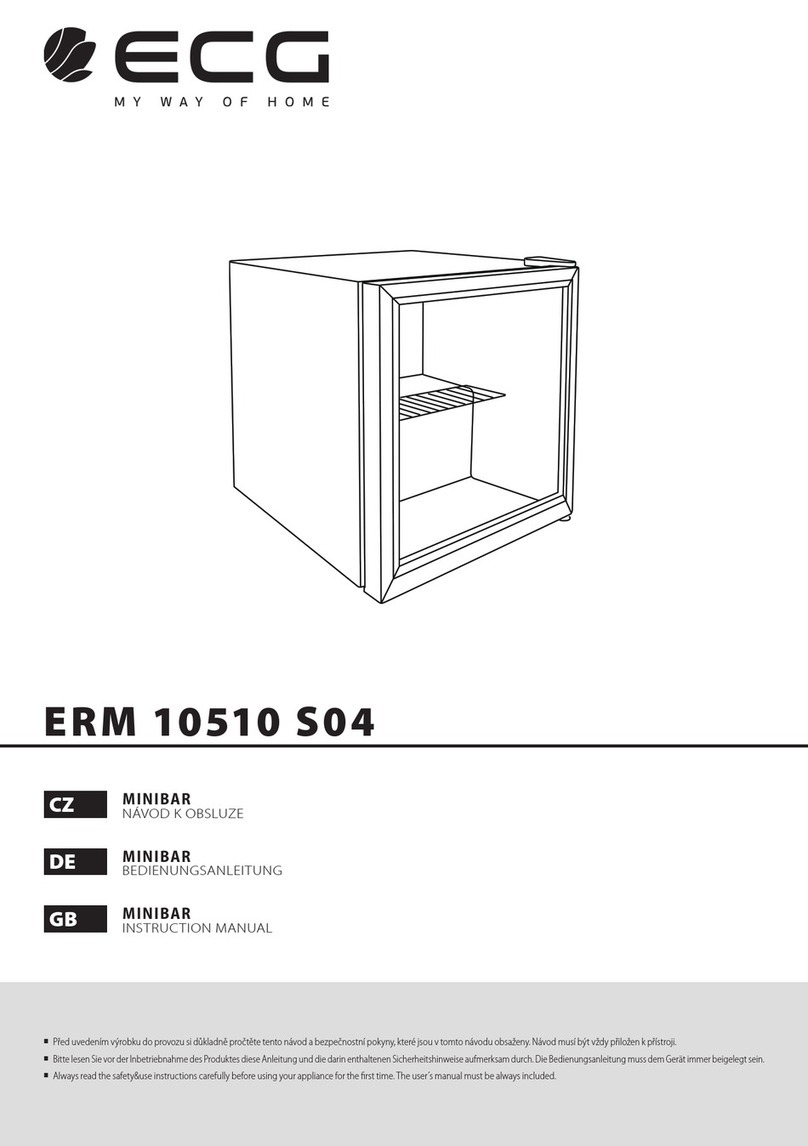
ECG
ECG ERM 10510 S04 User manual

ECG
ECG ERB 21700 WA+ User manual

ECG
ECG ERT 10860 WE User manual

